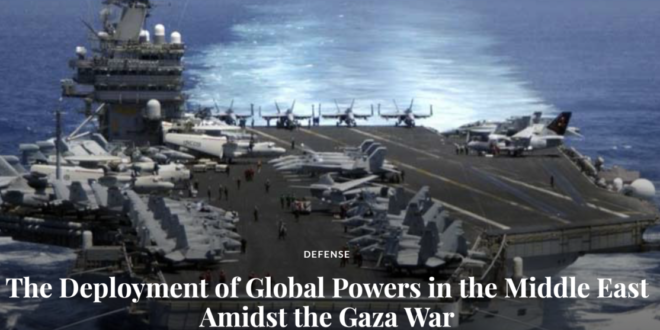The military operation initiated by Palestinian factions on October 7, 2023, served as a revealing moment for various regional and international dynamics, as well as the relative roles of each party in this equation that transcends regional security to international security. On the same day that U.S. President Joe Biden visited Israel, there was another visit of no less significance: Russian President Vladimir Putin met with Chinese President Xi Jinping in Beijing to discuss shared interests, including the Ukrainian crisis, Pacific security, and certainly the security situation in the Middle East.
Before delving into the military deployments that have come in response to this war, it is crucial to define some general frameworks that outline the stance of international powers towards this war:
Firstly, it is not in the interest of the United States and its European and Asian allies to open a new front of confrontation beyond Ukraine and the Pacific. The U.S. and its allies can barely cope in these challenging arenas and are competing in a critical moment of international power dynamics that could alter the global order, its rules, and the hierarchy of its actors. Conversely, the outbreak of an additional conflict would serve as a Trojan horse for the American alliance and would directly benefit China and Russia.
Secondly, the security system in the Eastern Mediterranean is severely disrupted, exacerbated by the growing distance between Russia and Israel since Russia’s annexation of Crimea in 2014. Israel complied with the sanctions imposed on Russia, followed by Russia’s military intervention in Syria, culminating in the Ukrainian crisis in the spring of 2022. During this crisis, Israel provided significant weapons, equipment, and expertise to the Ukrainians within the framework of the U.S.-led alliance against Russia.
Thirdly, the increasing tempo of Iranian-Arab understanding, particularly after the Iran-Saudi agreement sponsored by China, has led to the integration of Iran into the Arab political space. This poses risks to the trajectory of peace agreements overseen by the United States between Israel and its Arab neighbors.
Fourthly, the entry of the Middle East region, especially the Eastern Mediterranean, as critical points in the pathways of major geopolitical projects (notably the Silk Road and the economic corridor between India and Europe) has escalated the rates of collisions between these projects at critical junctures. Consequently, this has increased the cost of any conflict.
Based on the foregoing, it is possible to understand the overtly supportive American stance toward Israel and its consequent loss of a mediating role within some of the political dynamics in the United States. This overt support can largely be attributed to four main pillars that define the political orientation of the Biden administration toward this event:
- Maintaining the strategic relationship with Israel and rea rming commitment to the security of its major and strongest historical ally, while halting any attempts to change the American strategic equation in the region. This comes with collateral damages such as strained relations with some Arab countries or a further decline in its already tarnished reputation among Arab populations.
- The approach of the upcoming presidential elections for which Biden will run, and his keen interest in garnering support from Jewish and evangelical pressure groups. Hence, displaying clear support for Israel is imperative in this context.
- The issue of American hostages held by Hamas, which is closely related to elections; considering the bitter historical experience of President Jimmy Carter, whose major accomplishments did not save him from the hostage crisis at the American embassy in Tehran and su ered a crushing defeat against Republican President Ronald Reagan.
- Passage of the military aid package for Ukraine and the Pacific, and restructuring the severely a ected military-industrial complex due to the Ukrainian crisis, which had been rejected for a while by a Republican-controlled Congress. Israel was integrated into the package worth 105 billion dollars, receiving nearly 9 billion dollars, which may limit objections from Republicans, particularly those known for their interest and commitment to relations with Israel. If this package is passed, it will be a victory for Biden, ensuring the loyalty of the military-industrial complex and giving him smooth passage to the next electoral round.
U.S. Military Deployment in the Middle East
To address these issues, significant decisions have been made, such as deploying the aircraft carrier USS Gerald R. Ford to the Eastern Mediterraneanand promises to move another carrier to the same area, the USS Dwight D. Eisenhower. If this occurs, it will be one of the rare instances in post-World War II international conflict history where two carrier groups are deployed in the same region.
As for the deployment of the Gerald Ford, the newest carrier in the American fleet, at least half of its strike group remains in the Adriatic Sea to ensure regional security. The carrier is accompanied by the cruiser Normandy and destroyers Thomas Hudner, Ramage, Roosevelt, and Carney, all of which are relatively modern Arleigh Burke-class vessels.
According to the data provided, the carrier strike group, known as the Twelfth Carrier Strike
Group (12 CSG), has been deployed to various locations and tasks in the Eastern Mediterranean. Some were even positioned outside of the Eastern Mediterranean, like the destroyer USS Carney, which was recorded passing through the Suez Canal on the morning of October 19 and intercepted missiles targeting Israel near the Red Sea later the same day. It is unknown whether this presence in the Red Sea was due to prior intelligence about missile launches or if it was part of regular patrolling in the area.
On October 24, another destroyer, Thomas Hudner, was detected 107 kilometers from the Saudi coasts in the northern Red Sea, joining the Fifth Fleet and linking up with USS Carney. However, the extensive deployment of the Twelfth Carrier Strike Group in the region does not necessarily indicate readiness for a military strike.
It’s worth mentioning that the diverse range of tasks undertaken by this strike group has led to the Gerald Ford carrier being alone for extended periods, confirmed by multiple satellite observations, signaling a decreased risk level in the region.
In a related context, the aircraft carrier Gerald Ford was observed in the Eastern Mediterranean on October 16, according to official statements released by the U.S. administration.
However, on October 22, the carrier was spotted near the island of Crete, Greece, approximately 1,000 kilometers from the Eastern Mediterranean coasts.
Several scenarios may explain this repositioning, including refueling from the U.S. Navy’s logistical supply station at Souda Bay in Crete, due to the absence of accompanying logistical support ships with Task Force 12 in the Eastern Mediterranean. Another possibility is an increased security posture for the carrier and its group by maintaining a comfortable distance from the Eastern Mediterranean coasts where threats from Hezbollah are escalating. The group is believed to possess ballistic and cruise missiles capable of hitting, or at least damaging, the carrier at a distance of at least 600 kilometers. Satellite imagery has also revealed intense activity of U.S. reconnaissance and early-warning aircraft in the Eastern Mediterranean, with multiple sightings of the Boeing P-8 Poseidon maritime reconnaissance aircraft.
The flight path of the Poseidon aircraft was not fully visible on tracking services; it activated stealth mode before appearing in the Eastern Mediterranean and then disappeared again, ultimately reappearing near the island of Sicily, Italy. This suggests that the aircraft operates from the U.S. Naval Air Station Sigonella in Sicily. Concurrently, another aircraft conducting similar missions had its complete flight path monitored on October 22, providing insights into current U.S. strategic considerations. The full flight path of a U.S. reconnaissance aircraft of the RC-135V/W Rivet Joint model was recorded on October 22, taking o from Souda Bay in Crete to the Eastern Mediterranean and taking a vertical path along the Eastern Mediterranean coast before returning to Crete.
All these details indicate the possibility that the Gerald Ford carrier may position near the coasts of Crete, as it is currently not deemed necessary elsewhere, while utilizing reconnaissance and early warning flights available from Mediterranean and southern European bases. This aligns with recent shifts in U.S. political rhetoric. In the same vein, two
U.S. special forces transport aircraft were observed taking o from Lajes Field in the Azores, Portugal, near the Strait of Gibraltar, with their last observed location near the coast of Crete.
These details suggest the potential use of military and naval facilities on the island of Crete as a rear command site while ongoing surveillance of ground developments continues.
However, a point worthy of mention is that the USS Gerald R. Ford carrier group temporarily entered the European Command (EUCOM) operational sphere and exited the Central Command’s jurisdiction. This symbolically underscores the continued critical importance of the European theatre to the U.S. Sixth Fleet’s operations.
This occurs as U.S. forecasts and satellite images of the Eisenhower aircraft carrier group suggest it is heading toward the Arabian Gulf, likely to cross the Suez Canal on November 3 or 4, originating from the port of Norfolk, Virginia.
In conjunction with the American military presence, the British military is also deploying, as confirmed by the official statement from the UK Ministry of Defence. Two logistical support ships, Lyme Bay and Argus, were observed at the British naval base in Dhekelia, Cyprus, on October 20. The primary objective of the British armed forces at this time appears to be the evacuation of nationals in the event of escalated hostilities and an expanded regional conflict.
Chinese Military Deployment
Global newspapers reported on October 18 that China dispatched six warships to the Middle East. These vessels conducted joint exercises with the Omani navy before proceeding to an undisclosed location. According to a spokesperson for the Chinese Ministry of Defence, the 44th escort and protection task group arrived in the western Gulf of Aden on October 2 and conducted a joint training exercise with the 45th escort group before heading towards the Gulf of Oman for a joint exercise with the Omani navy on October 11, then departing Omani waters for Kuwait on October 16.
The deployment of naval escort groups by the People’s Liberation Army Navy (PLAN) signifies a strategic shift designed to contest the hegemony of the United States Navy in international maritime security operations—a sphere traditionally under the purview of the U.S. and its key allies, notably the United Kingdom and France. This strategy was operationalized in 2021, coinciding with a substantial increase in frigate production, thereby enhancing China’s capability for both domestic maritime security and overseas deployments.
The prioritization of the Middle East for these naval deployments is linked to China’s singular overseas naval base, situated in Djibouti, and underscores the region’s strategic significance for China, particularly in safeguarding oil trade routes. Currently, the PLAN maintains three naval escort groups, each consisting of a destroyer, a pair of frigates, and a logistical support vessel.
The 44th escort group is deployed in Kuwait and is slated for reassignment to the Horn of Africa before its scheduled return to China in November. Meanwhile, the 45th group is stationed in the Horn of Africa, with plans to return to China upon being relieved by the 44th group at the month’s end. The 43rd group was initially deployed to the Gulf of Guinea in July to bolster diplomatic ties with West African nations and has subsequently been reassigned to the Pacific as of September.
As for the potential of conflict involving these Chinese escort groups, the probability remains minimal. The Chinese political establishment is anticipated to persist in its policy of nonparticipation in international conflicts. Furthermore, these naval groups are unlikely to operate beyond the southern Red Sea, and in case of hostilities originating from Houthi forces, the groups are expected to circumvent the Bab al-Mandeb Strait to avert inadvertent clashes with U.S. forces.
Russian Military Expansion
Within the broader context of the Israeli-Palestinian conflict, Russia has articulated a notably explicit stance, unprecedented in its historical engagement with the region. This policy is bifurcated into two key frameworks:
- A categorical denunciation of Israel’s actions, combined with the strategic employment of empathetic discourse toward the Palestinian plight, aiming to elicit Arab solidarity and thus prolong the conflict.
- A doctrine of non-intervention, abstaining from proactive involvement in any potential resolution, as the extension of the conflict aligns with Russia’s geopolitical interests.
In this milieu, Russia’s initiation of maritime reconnaissance patrols in the Black Sea, executed by MiG-31 aircraft armed with hypersonic Kinzhal missilescapable of reaching targets in the Eastern Mediterranean, serves dual purposes. It acts both as a nuanced strategy for its ongoing operations in Ukraine and as a cautionary signal of potential risks in the Black Sea region. Importantly, this deployment also indicates that Russia’s military commitment to Ukraine does not preclude its capacity to intervene in the Eastern Mediterranean.
Moreover, apart from the presence of a Kilo-class diesel submarine detected in the Dover Strait of the English Channel—en route from the Black Sea to the Baltic Sea—Russian military activities in the Mediterranean remain relatively subdued. Russia also maintains routine flights from the Caucasus to Africa via its military installation in Syria.
Drawing upon the insights of historian Paul Kennedy in “The Rise and Fall of the Great Powers”, there appears to be no overt intention to entangle the Eastern Mediterranean in global conflict. Rather, emergent global powers such as Russia and China aim to isolate the United States through a strategy of ‘Imperial Overstretch,’ compelling a strategic retraction from the U.S. in both the European and Pacific theaters, thereby creating opportunities for a geopolitical reconfiguration in favor of Russia and China.
In cognizance of this overarching strategy, the United States has opted for rhetorical engagement in the current crisis, with a predilection for a restrained, formal role should the conflict escalate.
 Geostrategic Media Political Commentary, Analysis, Security, Defense
Geostrategic Media Political Commentary, Analysis, Security, Defense





